 |

Project
Management MGMT627
VU
LESSON
40
COST
MANAGEMENT AND CONTROL IN
PROJECTS
BROAD
CONTENTS
Cost
Management
Cost
Control
Management
Cost and Control System
(MCCS)
Understanding
Control
Operating
Cycle
Cost
Account Codes
Budgets
40.1
Cost
Management:
It
is widely used in business
today and is the process
whereby companies use cost
accounting to
report
or control various costs of
doing business. Cost
Management generally
describes
approach
and activities of managers in short range
and long range planning and
cost decisions
that
incorporate value for
customer and lower costs of
product and services.
Manager
make decisions on amount and kind of material
used, changes of plant
processes,
changes
in product designs and information
from accounting system helps
managers make such
decisions,
but information and accounting
system not "cost management"
project cost
management
broad focus includes continuous
control of costs. Planning and
cost is usually
linked
with revenue and profit
planning.
In
the context of
project:
Cost
management involves overall
planning, co-ordination, and control
and reporting of all
cost-related
aspects from "project
initiation" to "operation and
maintenance".
Process
of identifying all costs
associated with investment,
making informed choices
about
options
that will deliver best
"value for money" and
managing those costs
throughout life of
project.
Techniques (value management)
help to improve value and
reduce costs.
40.2
Cost
Control:
Cost
control is equally important to
all companies, regardless of
size. Small companies
generally
have tighter monetary controls,
mainly because of the risk
with the failure of as
little
as
one project, but with less
sophisticated control techniques. Large
companies may have the
luxury
to spread project losses
over several projects, whereas the small
company may have few
projects.
Cost
control is not only
"monitoring" of costs and recording
perhaps massive quantities of
data,
but
also analyzing of the data in
order to take corrective
action before it is too
late. Cost control
should
be performed by all personnel who
incur costs, not merely the
project office. Cost
control
implies good cost
management, which must
include:
�
Cost
estimating
�
Cost
accounting
�
Project
cash flow
�
Company
cash flow
�
Direct
labor costing
�
Overhead
rate costing
�
Others,
such as incentives, penalties, and
profit-sharing
308
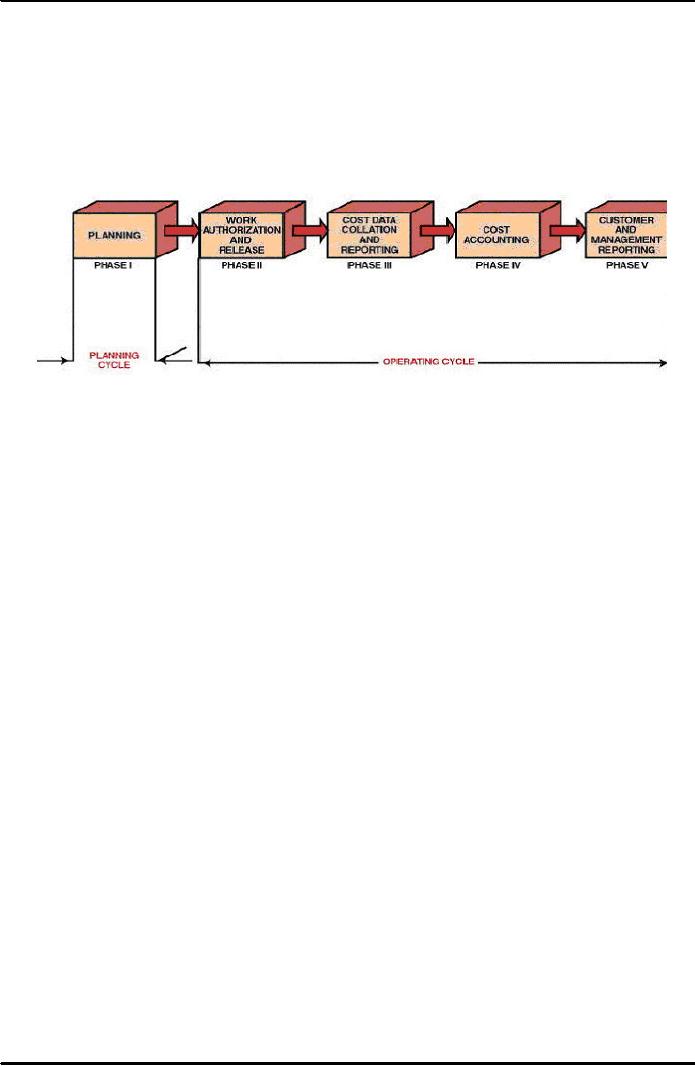
Project
Management MGMT627
VU
40.3
Management
Cost and Control System
(MCCS):
Cost
control is actually a subsystem of the
Management
Cost and Control System
(MCCS)
rather
than a complete system per se.
This is shown in Figure
40.1,
where
the Management Cost
and
Control System (MCCS) is
represented as a two cycle
process: a planning cycle
and an
operating
cycle. The operating cycle
is what is commonly referred to as the
cost control system.
Failure
of a cost control system to accurately
describe the true status of a
project does not
necessarily
imply that the cost control
system is at fault. Any cost
control system is only
as
good
as the original plan against which
performance will be measured. It is more common
for
the
plan to be at fault than the
control system.
Figure
40.1: Phases
of a Management Cost and
Control System
Therefore,
the designing of a company's planning
system must take into
account the cost
control
system
as well. For
this reason, it is common for the
planning cycle to be referred to
as
planning
and control, whereas the
operating cycle is referred to as
cost and control.
Note
that the planning and
control system selected must
be able to satisfy management's
needs
and
requirements in order that they
can accurately project the status
toward objective
completion.
The purpose of any
management cost and control
system is to establish policies,
procedures,
and techniques that can be used in the
day-to-day management and control
of
projects
and programs. The planning and control
system must, therefore,
provide information
that:
�
Gives
a picture of true work
progress
�
Will
relate cost and schedule
performance
�
Identifies
potential problems with respect to
their sources.
�
Provides
information to project managers
with a practical level of
summarization
�
Demonstrates
that the milestones are valid,
timely, and auditable
The
planning and control system, in
addition to being a tool by
which objectives can be
defined
that
is hierarchy
of objectives and
organization
accountability, exists as a
tool to develop
planning,
measure progress, and control
change. As a tool for
planning, the system must be
able
to:
�
Plan
and schedule work
�
Identify
those indicators that will
be used for
measurement
�
Establish
direct labor budgets
�
Establish
overhead budgets
�
Identify
management reserve
The
project budget that is the
final result of the planning
cycle of the MCCS must
be
reasonable,
attainable, and based on contractually
negotiated costs and the statement of
work.
The
basis for the budget is
historical cost, best
estimates, or industrial engineering
standards.
309

Project
Management MGMT627
VU
The
budget must identify planned
manpower requirements, contract-allocated funds,
and
management
reserve. Establishing budgets requires
that the planner fully understand
the
meaning
of standards.
We
should know that there are
two categories of standards. Performance
results standards are
quantitative
measurements and include such items as
quality of work, quantity of
work, cost of
work,
and time-to-complete. Process standards
are qualitative, including personnel,
functional,
and
physical factors relationships.
Standards
are advantageous in that
they provide a means for
unity, a basis for effective
control,
and
an incentive for others. The disadvantage
of standards is that performance is often
frozen,
and
employees are quite often
unable to adjust to the differences. As a
tool for measuring
progress
and controlling change, the systems
must be able to:
�
Measure
resources consumed
�
Measure
status and
accomplishments
�
Compare
measurements to projections and
standards
�
Provide
the basis for diagnosis and
re-planning
In
using the Management Cost
and Control System (MCCS),
the following
guidelines
usually
apply:
�
The
level of detail is specified by the
project manager with
approval by top
management.
�
Centralized
authority and control over
each project are the
responsibility of the project
management
division.
�
For
large projects, the project manager
may be supported by a project team
for utilization of
the
Management Cost and Control
System (MCCS).
Almost
all project planning and control
systems have identifiable design
requirements.
These
include:
�
A common
framework from which to
integrate time, cost, and
technical performance
�
Ability
to track progress of significant
parameters
�
Quick
response
�
Capability
for end-value
prediction
�
Accurate
and appropriate data for
decision making by each
level of management
�
Full
exception reporting with
problem analysis capability
�
Immediate
quantitative evaluation of alternative
solutions
Management
Cost and Control System
(MCCS) planning activities
include:
�
Contract
receipt (if
applicable)
�
Work
authorization for project
planning
�
Work
breakdown structure (WBS)
�
Subdivided
work description
�
Schedules
�
Planning
charts
�
Budgets
Management
Cost and Control System
(MCCS) planning charts are
worksheets used to create
the
budget. These charts include
planned labor in hours and material
dollars. Management
Cost
and
Control System (MCCS)
planning is accomplished in one of these
ways:
�
One
level below the lowest level
of the Work Breakdown Structure
(WBS)
�
At
the lowest management
level
�
By
cost element or cost
account
310

Project
Management MGMT627
VU
Even
with a fully developed
planning and control system,
there are numerous benefits and
costs.
The
appropriate system must consider a
cost-benefit analysis, and include such
items as:
�
Project
benefits:
o
Planning
and control techniques facilitate:
--
Derivation of output specifications
(project objectives)
--
Delineation of required activities
(work)
--
Coordination and communication between
organizational units
--
Determination of type, amount,
and timing of necessary
resources
--
Recognition of high-risk elements and
assessment of uncertainties
--
Suggestions of alternative courses of
action
--
Realization of effect of resource
level changes on schedule and
output
performance
--
Measurement and reporting of genuine
progress
--
Identification of potential
problems
--
Basis for problem solving,
decision making, and corrective
action
--
Assurance of coupling between planning
and control
�
Project
cost:
o
Planning
and control techniques
require:
--
New forms (new systems) of
information from additional
sources and
incremental
processing (managerial time, computer
expense, etc.)
--
Additional personnel or smaller span of
control to free managerial
time for
planning
and control tasks (increased
overhead)
--
Training in use of techniques (time
and materials)
A
well-disciplined Management Cost and
Control System (MCCS) will
produce the
following
results:
�
Policies
and procedures that will
minimize the ability to distort
reporting
�
Strong
management emphasis on meeting
commitments
�
Weekly
team meetings with a formalized
agenda, action items, and minutes.
�
Top-management
periodic review of the technical
and financial status
�
Simplified
internal audit for checking
compliance with
procedures
Furthermore,
for Management Cost and
Control System (MCCS) to be
effective, both the
scheduling
and budgeting systems must be
disciplines and formal in order to
prevent
inadvertent
or arbitrary budget or schedule
changes. This does not
mean
that the baseline
budget
and
schedule, once established, is static or
inflexible. Rather, it means
that changes must be
controlled
and result only from
deliberate management actions.
Disciplined
use of Management Cost and
Control System (MCCS) is designed to
put pressure
on
the project manager to perform
exceptionally good project
planning so that changes
will be
minimized.
As an example, government subcontractors
may not:
�
Make
retroactive changes to budgets or
costs for work that
has been completed.
�
Re-budget
work-in-progress activities
�
Transfer
work or budget independently of
each other
�
Reopen
closed work packages
In
some industries, the Management
Cost and Control System
(MCCS) must be used on
all
contracts
of $2 million or more, including firm
fixed-price efforts. The
fundamental test of
whether
to use the MCCS is to determine
whether the contracts have established
end-item
deliverables,
either hardware or computer software,
that must be accomplished
through
measurable
efforts.
311

Project
Management MGMT627
VU
Currently,
two new programs are
being used by the government and
industry in conjunction
with
the Management Cost and Control
System (MCCS) as an attempt to improve
effectiveness
in
cost control. The zero-base
budgeting program was established to
provide better
estimating
techniques
for the verification portion of
control. The design-to-cost program
assists the
decision-making
part of the control process by
identifying a decision-making framework
from
which
re-planning can take
place.
40.4
Understanding
Control:
Effective
management of a program during the
operating cycle requires that a
well-organized
cost
and control system be designed,
developed, and implemented so that
immediate feedback
can
be obtained, whereby the up-to-date
usage or resources can be
compared to target
objectives
established
during the planning cycle.
The requirements for an effective
control system (for
both
cost and schedule/performance) should
include:
�
Thorough
planning of the work to be performed to
complete the project
�
Good
estimating of time, labor, and
costs
�
Clear
communication of the scope of required
tasks
�
A
disciplined budget and authorization of
expenditures
�
Timely
accounting of physical progress and
cost expenditures
�
Periodic
re-estimation of time and cost to
complete remaining work
�
Frequent,
periodic comparison of actual progress and
expenditures to schedules and
budgets,
both at the time of comparison and at
project completion
It
is essential that the management
must compare the time, cost,
and performance of the
program
to the budgeted time, cost, and performance,
not independently but in an
integrated
manner.
Being within one's budget at
the proper time serves no
useful purpose if performance is
only
75 percent. Likewise, having a production
line turn out exactly
200 items, when
planned,
loses
its significance if a 50 percent cost
overrun is incurred.
All
three resource parameters (time,
cost, and performance) must be analyzed
as a group, or else
we
might ''win the battle but
lose the war." The use of
the expression "management cost and
control
system" is vague in that the implication is
made that only costs
are controlled. This
is
not
true-- an effective control
system monitors schedule and
performance as well as costs by
setting
budgets, measuring expenditures against budgets and
identifying variances, assuring
that
the
expenditures are proper, and
taking corrective action
when required.
Previously,
we defined the Work Breakdown Structure
(WBS) as the element that acts as
the
source
from which all costs and
controls must emanate. The
Work Breakdown Structure
(WBS)
is
the total project broken
down into successively lower
levels until the desired control
levels
are
established. The Work Breakdown Structure
(WBS) therefore serves as the
tool from which
performance
can be subdivided into
objectives and sub-objectives. As work
progresses, the
WBS
provides the framework on which
costs, time, and schedule/performance can
be compared
against
the budget for each level of
the WBS.
The
first purpose of control
therefore becomes a verification
process accomplished by the
comparison
of actual performance to date with the
predetermined plans and standards set
forth
in
the planning phase. The comparison
serves to verify
that:
�
The
objectives have been successfully translated
into performance standards.
�
The
performance standards are, in fact, a
reliable representation of program
activities and
events.
�
Meaningful
budgets have been established such
that actual versus planned
comparisons can
be
made.
312
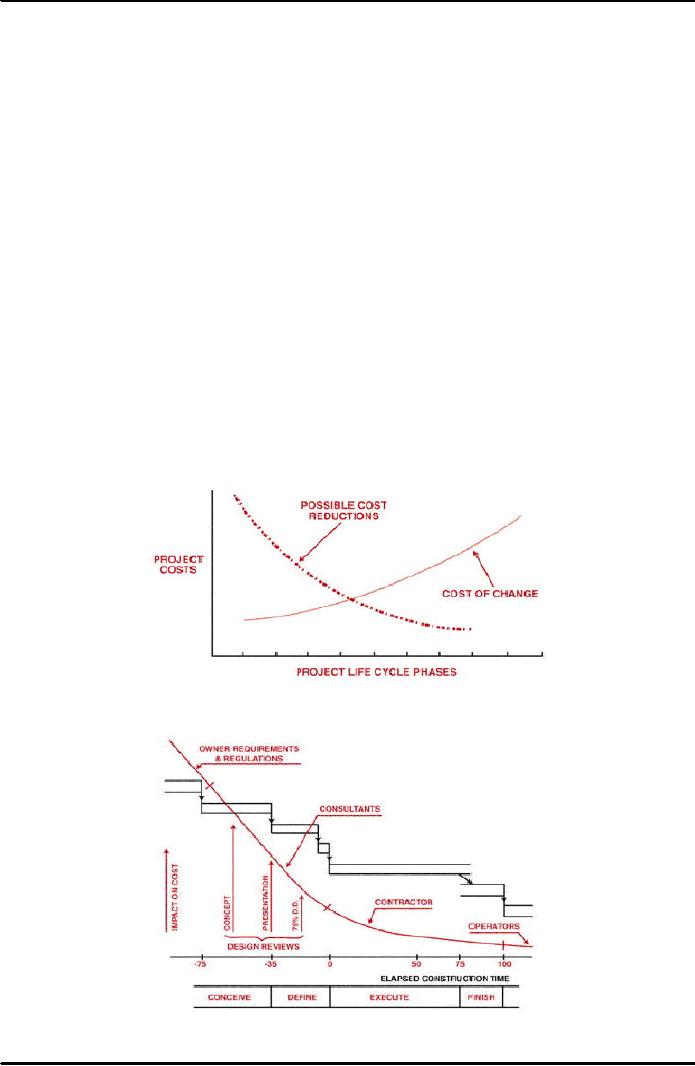
Project
Management MGMT627
VU
In
other words, the comparison verifies that
the correct standards were selected, and
that they
are
properly used. The second
purpose of control is that of
decision making. Three
useful
reports
are required by management in
order to make effective and
timely decisions:
�
The
project plan, schedule, and
budget prepared during the planning
phase.
�
A
detailed comparison between resources expended to
data and those predetermined.
This
includes
an estimate of the work remaining and the
impact on activity
completion.
�
A
projection of resources to be expended
through program
completion.
Afterwards,
these reports are then
supplied to both the managers
and the doers. Three
useful
results
arise through the use of
these three reports, generated during a
thorough decision-making
stage
of control:
�
Feedback
to management, the planners, and the
doers.
�
Identification
of any major deviations from
the current program plan,
schedule, or budget.
�
The
opportunity to initiate contingency
planning early enough that
cost, performance, and
time
requirements can undergo corrected action
without loss of
resources.
�
These
reports, if properly prepared, provide
management with the
opportunity to minimize
downstream
changes by making proper corrections
here and now. As shown in Figures
40.2
and
40.3, possible cost reductions are
usually available more readily in the
early project
phases,
but are reduced as we go
further into the project
life-cycle phases. Downstream the
cost
for changes could easily
exceed the original cost of the
project. This is an example
of
the
"iceberg" syndrome, where problems become
evident too late in the
project to be solved
easily,
resulting in a very high
cost to correct them.
Figure
40.2: Cost
Reduction Analysis
Figure
40.3: Ability to Influence
Cost
313

Project
Management MGMT627
VU
40.5
Operating
Cycle:
The
Management Cost and Control
System (MCCS) takes on paramount
importance during the
operating
cycle of the project. The
operating cycle is composed of
four phases:
�
Work
authorization and release (phase
II)
�
Cost
data collection and reporting
(phase III)
�
Cost
analysis (phase IV)
�
Reporting:
customer and management (phase
V)
These
four phases, when combined
with the planning cycle
(phase
I), constitute
a closed system
network
that forms the basis for the
management cost and control
system.
Phase
II is
considered as work release. After
planning is completed and a contract is
received,
work
is authorized via a work
description document. The work
description, or project
work
authorization
form, is a contract that contains the
narrative description, organization,
and time
frame
for each
Work
Breakdown Structure (WBS) level.
This multipurpose form is
used to
release
the contract, authorize planning, record
detail description of the work
outlined in the
Work
Breakdown Structure (WBS), and release
work to the functional
departments.
Note
that the contract services may
require a work description
form to release the contract.
The
contractual
work description form sets
forth general contractual requirements and
authorizes
program
management to proceed.
Program
management may then issue a
subdivided work description
form to the functional
units
so
that work can begin.
The subdivided work
description may also be
issued through the
combined
efforts of the project team, and
may be revised or amended
when either the scope
of
time
frame changes. The
subdivided work description
generally is not used for
efforts longer
than
ninety days and must be
"tracked" as if a project in itself.
This subdivided work
description
form
sets forth contractual requirements and
planning guidelines for the
applicable performing
organizations.
Also,
the subdivided work description
package established during the proposal
and updated
after
negotiations by the program team is
incrementally released by program
management to the
work
control centers in manufacturing
engineering, publications, and program
management as
the
authority for release of
work orders to the performing
organizations. The subdivided
work
description
specifies how contractual requirements
are to be accomplished, the
functional
organizations
involved, and their specific
responsibilities, and authorizes the expenditure
of
resources
within a particular time
frame.
The
work control center assigns
a work order number to the subdivided
work description
form,
if
no additional instructions are
required, and releases the document to
the performing
organizations.
If additional instructions are
required, the work control
center can prepare a more
detailed
work release document (shop traveler,
tool order, work order
release), assign the
applicable
work order number, and
release it to the performing
organization.
In
addition to this, a work
order number is required for
all in-house direct and indirect
charging.
The
work order number also
serves as a cross-reference number for
automatic assignment of the
indentured
work breakdown structure number to labor
and material data records in
the
computer.
In
case of small companies, they can
avoid this additional
paperwork cost by going
directly
from an awarded contract to a single
work order, which may be
the only work
order
needed for the entire
contract.
314
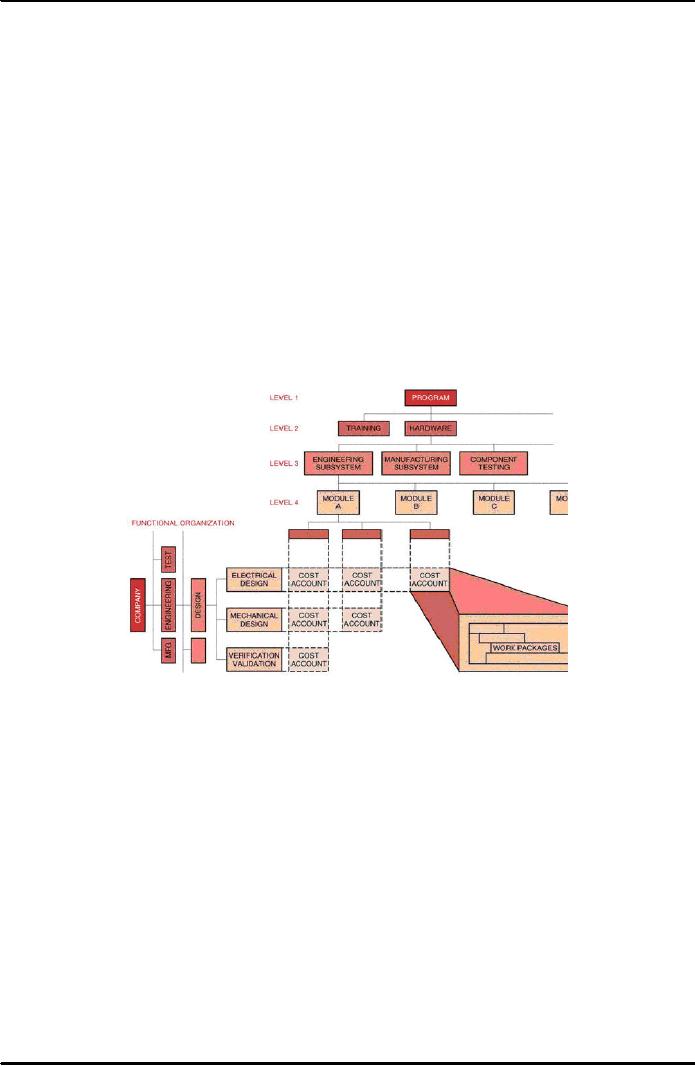
Project
Management MGMT627
VU
40.6
Cost
Account Codes:
It
must be noted that since
project managers control
resources through the line
managers rather
than
directly, project managers end up
controlling direct labor
costs by opening and
closing
work
orders. Work orders define the
charge numbers for each
cost account. By definition, a
cost
account
is an identified level at a natural
intersection point of the work
breakdown structure and
the
Organizational
Breakdown Structure (OBS)
at
which functional responsibility
for the work
is
assigned, and actual direct
labor, material, and other
direct costs are compared
with actual
work
performed for management
control purposes.
Cost
accounts are the focal point
of the Management Cost and Control
System (MCCS) and
may
comprise several work packages, as shown in
Figure 40.4. Work packages
are detailed
short
span job or material items
identified for the accomplishment of
required work. To
illustrate
this, consider the cost account
code breakdown shown in Figure
40.5 and the work
authorization
form shown in Figure 40.6.
The work authorization form
specifically identifies the
cost
centers that are "open"
for this charge number, the
man-hours available for each
cost
center,
and the operational time period
for the charge number.
Because the exact dates of
operation
are completely defined, the
charge number can be assigned
perhaps as much as a
year
in
advance of the work-begin date. This
can be shown pictorially, as in Figure
40.7.
Figure
40.4: Cost
Account Intersection
If
the man-hours are assigned to cost
center 2400, then any
24xx cost center can
use this charge
number.
If the work authorization
form specifies cost center
2610, then any 261x
cost center
can
use the charge
number.
However,
if cost center 2623 is
specified, then no lower
cost accounts exist, and
this is the only
cost
center that can use
this work order charge
number. In other words, if a charge
number is
opened
up at the department level, then the department
manager has the right to
subdivide the
assigned
man-hours among the various sections and
subsections.
Company
policy usually identifies the permissible
cost center levels that
can be assigned in the
work
authorization form. These
permissible levels are
related to the work
breakdown structure
level.
For example, cost center
5000 (i.e., divisional) can
be assigned at the project level of
the
work
breakdown structure, but only department,
sectional, or sub-sectional cost accounts
can be
assigned
at the task level of the work
breakdown structure.
315
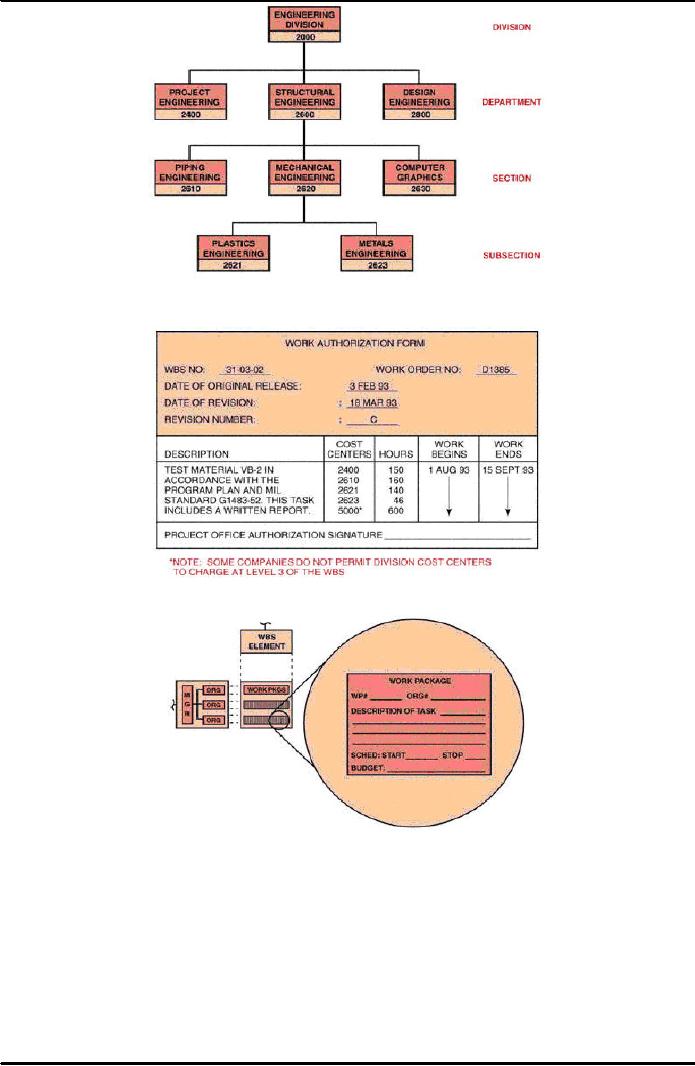
Project
Management MGMT627
VU
Figure
40.5: Cost
Account Code Breakdown
Figure
40.6: Work
Authorization Form
Figure
40.7: Planning
and Budgeting Describe, Plan, and
Schedule the Work
If
a cost center needs
additional time or additional man-hours,
then a cost account change
notice
form
must be initiated, usually by the
requesting cost center, and approved by the
project office.
The
following Figure 40.8 shows
a typical cost account
change notice form.
316
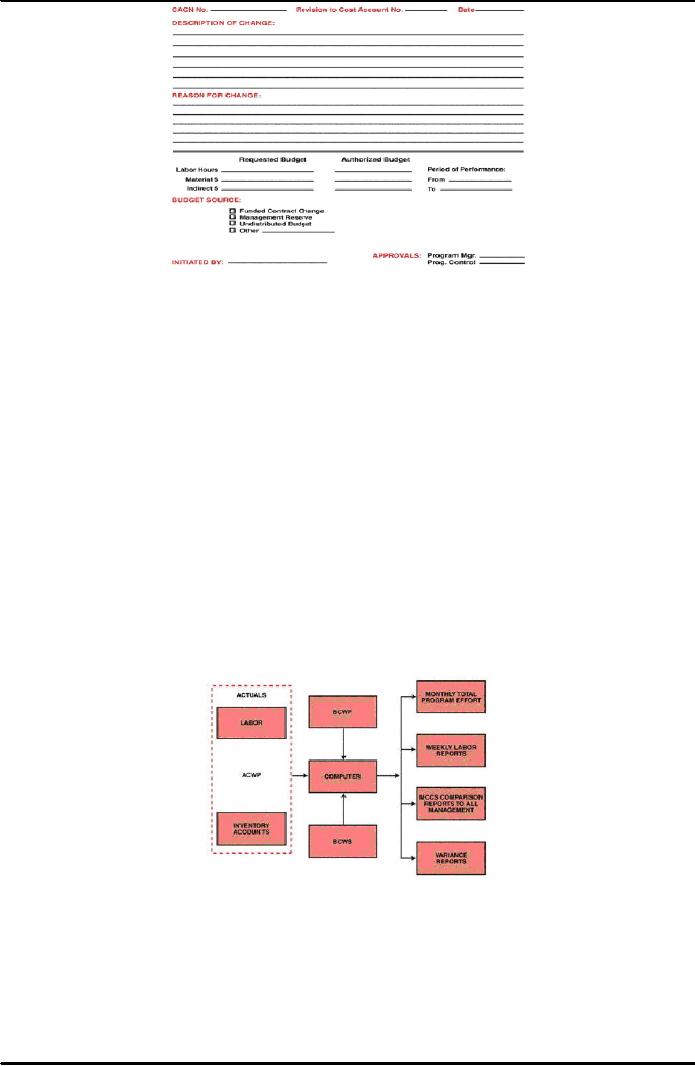
Project
Management MGMT627
VU
Figure
40.8: Cost
Account Change Notice
(CACN)
Almost
all large companies have computerized
cost control and reporting
systems. Small
companies
have manual or partially computerized systems.
The major difficulty in
using the
cost
account code breakdown and the
work authorization form
(shown in Figures 40.5 and
40.6)
is
related to whether the employees fill
out time cards, and
frequency with which the
time cards
are
filled out.
Project-driven
organizations fill out time
cards at least once a week,
and the cards are
inputted
to
a computerized system. Nonproject-driven
organizations fill out time
cards on a monthly
basis,
with computerization depending on the
size of the company.
Cost
data collection and reporting
constitute the second phase of the
operating cycle of the
Management
Cost and Control System
(MCCS). Actual
cost for work performed
(ACWP) and
the
budgeted
cost for work performed
(BCWP) for
each contract or in-house project
are
accumulated
in detailed cost accounts by
cost center and cost element, and
reported in
accordance
with the flow charts shown in
Figure 40.9. These detailed
elements, for both
actual
costs
incurred and the budgeted cost for
work performed, are usually
printed out monthly for
all
levels
of the work breakdown structure. In
addition, weekly supplemental direct
labor reports
can
be printed showing the actual labor
charge incurred, and can be
compared to the predicted
efforts.
Figure
40.9: Cost
Data Collection and Reporting Flow
Chart
The
following Table 40.1 shows a
typical weekly labor report.
The first column identifies
the
Work
Breakdown Structure (WBS) number. If more
than one work order were
assigned to this
Work
Breakdown Structure (WBS) element, then
the work order number would
appear under
the
WBS number. This procedure
would be repeated for all
work orders under the same
WBS
number.
The second column contains the
cost centers charging to
this WBS element (and
possibly
work order numbers). Cost Center
41xx represents department 41 and is a
rollup of
Cost
Centers 4110, 4115, and
4118. Cost Center 4xxx
represents the entire division
and is a
317
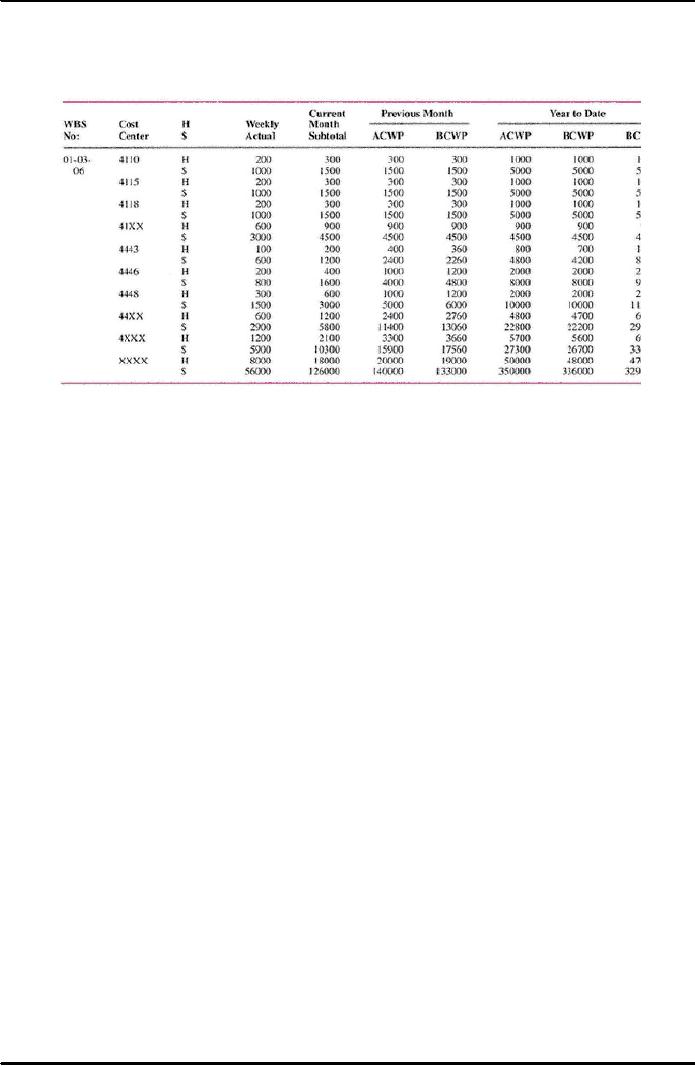
Project
Management MGMT627
VU
rollup
of all 4000-level departments.
Cost Center xxxx represents the
total for all
divisions
charging
to this Work Breakdown Structure
(WBS) element. The weekly
labor reports must
list
all
cost centers authorized to
charge to this WBS element,
whether or not they have
incurred
any
costs over the last reporting
period.
Table
40.1: Weekly
Labor Report
Note
that most weekly labor
reports provide current month subtotals
and previous month
totals.
Although
these also appear on the
detailed monthly report,
they are included in the
weekly
report
for a quick and dirty comparison.
Year-to-date totals are
usually not on the weekly
report
unless
the users request them for an
immediate comparison to the estimate
at completion (EAC)
and
the work order
release.
Weekly
labor output is a vital tool
for members of the program
office in that these reports
can
indicate
trends in cost and performance in
sufficient time for
contingency plans to be
established
and implemented. If these reports are
not available, then cost and
labor overruns
would
not be apparent until the following
month when the detailed
monthly labor, cost,
and
materials
output was obtained. In
Table 40.1, Cost Center 4110
has spent its entire
budget. The
work
appears to be completed on schedule. The
responsible program office team
may wish to
eliminate
this cost center's authority
to continue charging to this
Work Breakdown Structure
(WBS)
element by issuing a new SWD or
work order canceling this
department's efforts.
Cost
Center
4115 appears to be only
halfway through.
If
time is becoming short, then
Cost Center 4115 must add
resources in order to
meet
requirements.
Cost Center 4443 appears to be
heading for an overrun. This
could also indicate a
management
reserve. In this case the responsible
program team member feels
that the work can
be
accomplished in fewer hours.
Work
order releases are used to
authorize certain cost
centers to begin charging
their time to a
specific
cost reporting element. Work
orders specify hours, not
dollars. The hours indicate
the
''targets"
that the program office
would like to have the department shoot
for. If the program
office
wished to be more specific and "compel"
the departments to live within
these hours, then
the
budgeted
cost for work scheduled
(BCWS) should
be changed to reflect the reduced
hours.
Four
categories of cost data are
normally accumulated:
�
Labor
�
Material
�
Other
direct charges
�
Overhead
318

Project
Management MGMT627
VU
We
know that the project
managers can maintain
reasonable control over
labor, material, and
other
direct charges.
On
the other hand, overhead costs are
calculated yearly or monthly and applied
retroactively to
all
applicable programs. Management reserves
are often used to counterbalance the
effects of
adverse
changes in overhead rates.
40.7
Budgets:
The
project budget, which is the
final result of the planning
cycle of the Management Cost
and
Control
System (MCCS), must be
reasonable,
attainable, and
based on:
�
Contractually
negotiated costs, and
�
The
statement of work
The
basis for the budget
is:
�
Historical
cost,
�
Best
estimates, or
�
Industrial
engineering standards
The
budget must identify:
�
Planned
manpower requirements,
�
Contract
allocated funds, and
�
Management
reserve.
All
budgets must be traceable through the
budget "log," which
includes:
�
Distributed
budget
�
Management
reserve
�
Undistributed
budget
�
Contract
changes
It
is important to note that the
management reserve is the dollar amount
established by the
project
office to budget for all
categories of unforeseen problems and contingencies
resulting in
out-of-scope
work to the performers. Management
reserve should be used for
tasks or dollars,
such
as rate changes, and not to cover up bad
planning estimates or budget
overruns. When a
significant
change occurs in the rate structure, the
total performance budget should be
adjusted.
In
addition to the "normal" performance
budget and the management reserve
budget, there also
exists
the following:
�
Undistributed
budget,
which is that budget
associated with contract changes where
time
constraints
prevent the necessary planning to
incorporate the change into the
performance
budget.
(This effort may be
time-constrained.)
�
Unallocated
budget,
which represents a logical
grouping of contract tasks
that have
not
yet been identified and/or
authorized.
Variance:
A
variance is defined as any
schedule, technical performance, or cost
deviation from a
specific
plan.
Variances are used by all
levels of management to verify the
budgeting system and the
scheduling
system. The budgeting and
scheduling system variance
must be compared
together
because:
�
The
cost variance compares
deviations only from the
budget and does not provide
a
measure
of comparison between work scheduled and
work accomplished.
319

Project
Management MGMT627
VU
�
The
scheduling variance provides a comparison
between planned and actual performance
but
does not include
costs.
There
are two primary methods of
measurement:
�
Measurable
efforts: Discrete
increments of work with a definable
schedule for
accomplishment,
whose completion produces
tangible results.
�
Level
of effort: Work
that does not lend
itself to subdivision into discrete
scheduled
increments
of work, such as project support and
project control.
Variances
are used on both types of
measurement:
In
order to calculate variances we must
define the three basic variances for
budgeting and actual
costs
for work scheduled and
performed. Archibald defines these
variables:
�
Budgeted
cost for work scheduled
(BCWS) is the budgeted amount of cost for
work
scheduled
to be accomplished plus the amount or level of
effort or apportioned
effort
scheduled
to be accomplished in a given time
period.
�
Budget
cost for work performed
(BCWP) is the budgeted amount of cost for
completed
work,
plus budgeted for level of
effort or apportioned effort
activity completed within a
given
time period. This is
sometimes referred to as "earned
value."
�
Actual
cost for work performed
(ACWP) is the amount reported as actually
expended in
completing
the work accomplished within a given
time period.
320
Table of Contents:
- INTRODUCTION TO PROJECT MANAGEMENT:Broad Contents, Functions of Management
- CONCEPTS, DEFINITIONS AND NATURE OF PROJECTS:Why Projects are initiated?, Project Participants
- CONCEPTS OF PROJECT MANAGEMENT:THE PROJECT MANAGEMENT SYSTEM, Managerial Skills
- PROJECT MANAGEMENT METHODOLOGIES AND ORGANIZATIONAL STRUCTURES:Systems, Programs, and Projects
- PROJECT LIFE CYCLES:Conceptual Phase, Implementation Phase, Engineering Project
- THE PROJECT MANAGER:Team Building Skills, Conflict Resolution Skills, Organizing
- THE PROJECT MANAGER (CONTD.):Project Champions, Project Authority Breakdown
- PROJECT CONCEPTION AND PROJECT FEASIBILITY:Feasibility Analysis
- PROJECT FEASIBILITY (CONTD.):Scope of Feasibility Analysis, Project Impacts
- PROJECT FEASIBILITY (CONTD.):Operations and Production, Sales and Marketing
- PROJECT SELECTION:Modeling, The Operating Necessity, The Competitive Necessity
- PROJECT SELECTION (CONTD.):Payback Period, Internal Rate of Return (IRR)
- PROJECT PROPOSAL:Preparation for Future Proposal, Proposal Effort
- PROJECT PROPOSAL (CONTD.):Background on the Opportunity, Costs, Resources Required
- PROJECT PLANNING:Planning of Execution, Operations, Installation and Use
- PROJECT PLANNING (CONTD.):Outside Clients, Quality Control Planning
- PROJECT PLANNING (CONTD.):Elements of a Project Plan, Potential Problems
- PROJECT PLANNING (CONTD.):Sorting Out Project, Project Mission, Categories of Planning
- PROJECT PLANNING (CONTD.):Identifying Strategic Project Variables, Competitive Resources
- PROJECT PLANNING (CONTD.):Responsibilities of Key Players, Line manager will define
- PROJECT PLANNING (CONTD.):The Statement of Work (Sow)
- WORK BREAKDOWN STRUCTURE:Characteristics of Work Package
- WORK BREAKDOWN STRUCTURE:Why Do Plans Fail?
- SCHEDULES AND CHARTS:Master Production Scheduling, Program Plan
- TOTAL PROJECT PLANNING:Management Control, Project Fast-Tracking
- PROJECT SCOPE MANAGEMENT:Why is Scope Important?, Scope Management Plan
- PROJECT SCOPE MANAGEMENT:Project Scope Definition, Scope Change Control
- NETWORK SCHEDULING TECHNIQUES:Historical Evolution of Networks, Dummy Activities
- NETWORK SCHEDULING TECHNIQUES:Slack Time Calculation, Network Re-planning
- NETWORK SCHEDULING TECHNIQUES:Total PERT/CPM Planning, PERT/CPM Problem Areas
- PRICING AND ESTIMATION:GLOBAL PRICING STRATEGIES, TYPES OF ESTIMATES
- PRICING AND ESTIMATION (CONTD.):LABOR DISTRIBUTIONS, OVERHEAD RATES
- PRICING AND ESTIMATION (CONTD.):MATERIALS/SUPPORT COSTS, PRICING OUT THE WORK
- QUALITY IN PROJECT MANAGEMENT:Value-Based Perspective, Customer-Driven Quality
- QUALITY IN PROJECT MANAGEMENT (CONTD.):Total Quality Management
- PRINCIPLES OF TOTAL QUALITY:EMPOWERMENT, COST OF QUALITY
- CUSTOMER FOCUSED PROJECT MANAGEMENT:Threshold Attributes
- QUALITY IMPROVEMENT TOOLS:Data Tables, Identify the problem, Random method
- PROJECT EFFECTIVENESS THROUGH ENHANCED PRODUCTIVITY:Messages of Productivity, Productivity Improvement
- COST MANAGEMENT AND CONTROL IN PROJECTS:Project benefits, Understanding Control
- COST MANAGEMENT AND CONTROL IN PROJECTS:Variance, Depreciation
- PROJECT MANAGEMENT THROUGH LEADERSHIP:The Tasks of Leadership, The Job of a Leader
- COMMUNICATION IN THE PROJECT MANAGEMENT:Cost of Correspondence, CHANNEL
- PROJECT RISK MANAGEMENT:Components of Risk, Categories of Risk, Risk Planning
- PROJECT PROCUREMENT, CONTRACT MANAGEMENT, AND ETHICS IN PROJECT MANAGEMENT:Procurement Cycles